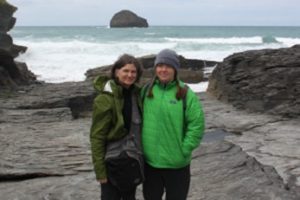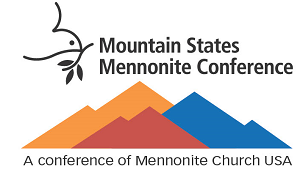by Jill Minter, Boulder Mennonite Church
[Printed in the April 26, 2017 issue of PeaceSigns, the magazine of the Peace and Justice Support Network, Mennonite Church USA. Reprinted here with permission.]

We, her parents, think Laura is pretty amazing. At school, her classes include algebra, language arts, life science, U.S. history, American Sign Language and art. She is a team manager for the freshmen girls’ volleyball team. And this winter, she was part of the Indoor Percussion Team. Like any teenager, she has hopes and dreams for her future – to graduate from high school, to go to college, to study and work in sports and recreation, and to share a house with her best friend.
Sounds like a normal teenager, right?
Right.
And this is the point. Disability is normal — it is part of the human experience.
But the hard part is that the world that we must prepare Laura to enter is a world that does not see or treat her like a normal citizen. The world Laura faces looks like this:
Education: Our public schools believe that inclusive education means being in the same room as your classmates while they learn and you don’t. Parents feel they have to “sell their child with special needs” to the teachers in order to get the instruction and resources their child needs. Teachers feel that teaching your child “is someone else’s job.” Principals say your child has “plateaued,” not believing that something in the classroom could be changed.
Employment: The unemployment rate for people with disabilities is increasing. As of 2015, only 17.5% of people with disabilities are employed[1]. We want Laura to be one of them.
Healthcare: Many doctors are not trained in caring for people with disabilities and, as a result, many people with disabilities receive substandard care. For example, women with cerebral palsy are three times more likely to die of breast cancer than women without disabilities[2].
Housing: People with disabilities who want to live independently face a severe housing crisis. For many, their monthly income is below the average rent and many face housing discrimination.
Violence: Over half of the people killed by police over the past year were people with developmental disabilities or mental illness[3]. Students with disabilities are more likely to be bullied than students without disabilities[4]
The statistics facing Laura are agonizing. And such marginalization, which infiltrates all areas of life including in the church, is fostered by enduring stigmas about disabilities. Today, the biggest barriers to meaningful inclusion are attitudes, not resources. Laura and our family have experienced numerous hurtful stigmas about disability. Many people believe that those with disabilities are either: objects of pity, a burden of charity, less than fully human and not deserving of all rights, holy innocents (often viewed as “eternal children”), sick, or even a danger to society. Each of these stigmas or beliefs is dehumanizing and depicts lives, like Laura’s, as abnormal or wrong.
These stigmas foster discrimination and exclusion. The abuse experienced by people with disabilities is a really big social justice issue! And yet, I have found that the church remains largely silent. Statistics indicate that 1 in 5 people live with a disability[5], and although this means that 134,000 Mennonites in North America have disabilities, people in the church often hold those same erroneous beliefs and attitudes about people with disabilities. Embracing those negative stigmas a means that the church is not equipped to meet the spiritual, emotional, or physical needs of this large group of people. In fact, with regard to accessibility and accommodation, most church practices do not even meet the basic standards of accommodations that the public sphere must comply with under the Americans with Disabilities Act (ADA).
The experience of marginalization in daily life and in church life has resulted in feelings of intense isolation for our family. Other parents don’t know how to relate, so they have excluded us from conversations and group activities. Despite the huge role that disability plays in our family, relatives and people from church feel uncomfortable speaking about or acknowledging Laura’s disability. Even though we need support, we often feel left with only superficial relationships.
Justice, belonging, and support for those with disabilities should begin in the church. I am convinced that the only way churches will become places of belonging for families like ours is by changing personal attitudes. To do this we must:
Think carefully about biases and stigmas and how they present in daily life. We all internalize stigmas and need to recognize them in order to check them at the door.
Persevere in learning to be comfortable with people who are different and to view differences as normal.
Initiate friendships with people with disabilities. Allow yourself to receive their gifts.
As parents, we want Laura to feel like she has friends at church, people who are happy to see her and miss her when she is not there. We want her to feel that she belongs to a loving church community. Laura needs more people in her life than just her parents.
My take away message is an appeal to you to work hard to eliminate your own stigmas about disability. Strive to create meaningful friendships with those who have developmental disabilities, especially within your church. It’s up to you to turn the church and the world into a more hospitable and hopeful place for people like our daughter Laura.
We must embrace our differences, even celebrate our diversity.
We must glory in the fact that God created each of us as unique human beings.
God created us different, but God did not create us for separation.
God created us different that we might recognize our need for one another.
–Desmond Tutu
[2] “Women with Disabilities More at Risk of Breast Cancer – News and Events – University of Sydney.” Accessed April 17, 2017. http://sydney.edu.au/news/84.html?newsstoryid=610.
[3] “Ruderman Family Foundation » Ruderman White Paper.” Accessed April 17, 2017. http://www.rudermanfoundation.org/news-and-events/ruderman-white-paper.
[4] “Bullying and Youth with Disabilities and Special Health Needs,” March 8, 2012. https://www.stopbullying.gov/at-risk/groups/special-needs/index.html.
[5] Office, US Census Bureau Public Information. “Nearly 1 in 5 People Have a Disability in the U.S., Census Bureau Reports – Miscellaneous – Newsroom – U.S. Census Bureau.” Accessed April 17, 2017. https://www.census.gov/newsroom/releases/archives/miscellaneous/cb12-134.html.
Moving Beyond Ableism is a quarterly column featuring the work of the Anabaptist Disabilities Network (ADNet) www.adnetonline.org and offers reflections from different authors on the various issues facing persons with disabilities.
